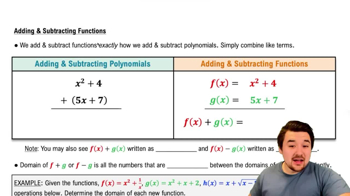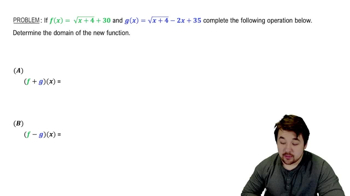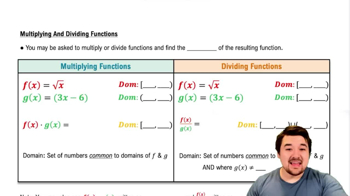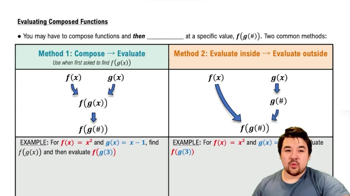Table of contents
- 0. Functions7h 52m
- Introduction to Functions16m
- Piecewise Functions10m
- Properties of Functions9m
- Common Functions1h 8m
- Transformations5m
- Combining Functions27m
- Exponent rules32m
- Exponential Functions28m
- Logarithmic Functions24m
- Properties of Logarithms34m
- Exponential & Logarithmic Equations35m
- Introduction to Trigonometric Functions38m
- Graphs of Trigonometric Functions44m
- Trigonometric Identities47m
- Inverse Trigonometric Functions48m
- 1. Limits and Continuity2h 2m
- 2. Intro to Derivatives1h 33m
- 3. Techniques of Differentiation3h 18m
- 4. Applications of Derivatives2h 38m
- 5. Graphical Applications of Derivatives6h 2m
- 6. Derivatives of Inverse, Exponential, & Logarithmic Functions2h 37m
- 7. Antiderivatives & Indefinite Integrals1h 26m
- 8. Definite Integrals4h 44m
- 9. Graphical Applications of Integrals2h 27m
- 10. Physics Applications of Integrals 2h 22m
0. Functions
Combining Functions
Problem 1.96c
Textbook Question
Inverse of composite functions
c. Explain why if g and h are one-to-one, the inverse of ƒ(x) = g(h(x)) exists.
 Verified step by step guidance
Verified step by step guidance1
To determine if the inverse of a composite function \( f(x) = g(h(x)) \) exists, we first need to understand the concept of one-to-one functions. A function is one-to-one (injective) if each output is mapped from a unique input, meaning no two different inputs produce the same output.
Given that both \( g \) and \( h \) are one-to-one functions, we can infer that \( h(x) \) maps each input \( x \) to a unique output \( y \), and then \( g(y) \) maps each \( y \) to a unique output \( z \). This ensures that the entire mapping from \( x \) to \( z \) through \( g(h(x)) \) is also one-to-one.
Since \( f(x) = g(h(x)) \) is a composition of two one-to-one functions, it is itself one-to-one. This is because the composition of two injective functions is injective.
For a function to have an inverse, it must be both one-to-one and onto (bijective). In this context, we are primarily concerned with the injective property, which is satisfied as shown.
Therefore, since \( f(x) = g(h(x)) \) is one-to-one, it has an inverse function \( f^{-1}(x) \), which can be found by reversing the operations of \( g \) and \( h \) in the reverse order, i.e., \( f^{-1}(x) = h^{-1}(g^{-1}(x)) \).
 Verified video answer for a similar problem:
Verified video answer for a similar problem:This video solution was recommended by our tutors as helpful for the problem above
Video duration:
4mPlay a video:
Was this helpful?
Key Concepts
Here are the essential concepts you must grasp in order to answer the question correctly.
One-to-One Functions
A function is considered one-to-one (injective) if it assigns distinct outputs to distinct inputs. This means that for any two different inputs, the outputs will also be different. One-to-one functions are crucial for the existence of inverses because they ensure that each output corresponds to exactly one input, preventing ambiguity in reversing the function.
Recommended video:

One-Sided Limits
Composite Functions
A composite function is formed when one function is applied to the result of another function, denoted as ƒ(x) = g(h(x)). The inner function h(x) is evaluated first, followed by the outer function g. Understanding composite functions is essential for analyzing the behavior of combined transformations and determining the conditions under which their inverses exist.
Recommended video:

Evaluate Composite Functions - Special Cases
Existence of Inverses
For a function to have an inverse, it must be bijective, meaning it is both one-to-one and onto. In the case of composite functions, if both g and h are one-to-one, then their composition g(h(x)) will also be one-to-one. This guarantees that the inverse function exists, as each output from the composite function can be traced back to a unique input.
Recommended video:

Inverse Cosine

 5:56m
5:56mWatch next
Master Adding & Subtracting Functions with a bite sized video explanation from Nick
Start learning




